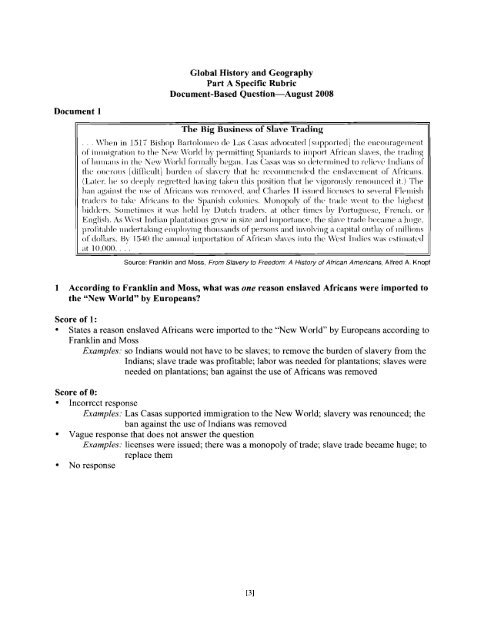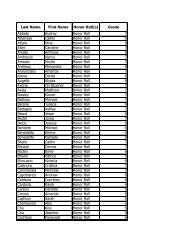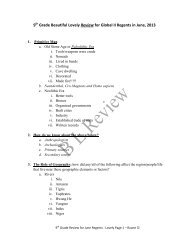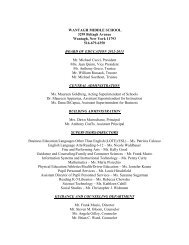Answers for the DBQ - Wantagh School
Answers for the DBQ - Wantagh School
Answers for the DBQ - Wantagh School
Create successful ePaper yourself
Turn your PDF publications into a flip-book with our unique Google optimized e-Paper software.
Global History and Geography<br />
Part A Specific Rubric<br />
Document-Based Question-August 2008<br />
Document 1<br />
The Big Business of Slave 'li-ading<br />
. . . \\,'hen in 1517 Bishop Barto1omr.o de Las (;asas advocatetl ~sr~p~orterl] <strong>the</strong> enco~~rr~ge~neilt<br />
of in~~rligr;~tion to <strong>the</strong> Se\v \\'orld 1)y 1)rrinitting Spaniards to inlport African sl;lves, <strong>the</strong> trilvc. Iridia~rs of<br />
tllc; OII(~~OIIS [difficult] l~urden of slaveiy tliat he rcc.ornrricndc.d thc ens1;tvcnlcnt of Africails.<br />
(La1t.r. l~e so deeply rrgrcttetl having taliell this position that he vigoro~lsly renorlnced it.) The<br />
lxln aptillst <strong>the</strong> list. of' Af'rir*;uls was re~lloved, il~ld C:llarles I T issi~ed lir:e~rses to several Fle~nish<br />
tra(h:rs to t;lkr, Afi-icr~~rs to t11c Spiinish r:olo~iic,s. Monopoly of <strong>the</strong>, trac.!(, \vcblit to t11c Iriglrc~st<br />
1)itltlcrs. Soilieti~~lcs it \\.;is lrc~ltl 1 ) Dutcll ~ tradcrs. at o<strong>the</strong>r ti~rles 1)y Portuguc~se, Frcnch. or<br />
Endish. ils M'wt Jntlian plantations grtw in size ant1 iml)ortance, <strong>the</strong> slave trade heca~ne a hrigc.,<br />
h.<br />
l)rolit;tl,le ii~rd(~rtitking elr1~11oying tho~is;t~-rds of persons ;~nd involviirg ;I c:;q>ital oi~tli~y of ~nillinrrs<br />
of dollars. Hy 1.540 t11c' ;i111111iil i~rl~)ortatioli of Afrie;ir) ~Iiivi:~ illto tlre \,Vc,st Ir~dies \viis cstin~iitctl<br />
;>t 1 0000. . .<br />
Source: Franklin and Moss, From Slavery to Freedom: A History of African Americans, Alfred A. Knopf<br />
1 According to Franklin and Moss, what was one reason enslaved Africans were imported to<br />
<strong>the</strong> "New World" by Europeans?<br />
Score of 1:<br />
States a reason enslaved Africans were imported to <strong>the</strong> "New World" by Europeans according to<br />
Franklin and Moss<br />
Examples: so Indians would not have to be slaves; to remove <strong>the</strong> burden of slavery fiom <strong>the</strong><br />
Indians; slave trade was profitable; labor was needed <strong>for</strong> plantations; slaves were<br />
needed on plantations; ban against <strong>the</strong> use of Africans was removed<br />
Score of 0:<br />
Incorrcct response<br />
Examples: Las Casas supported immigration to <strong>the</strong> New World; slavery was renounced; <strong>the</strong><br />
ban against <strong>the</strong> use of Indians was removed<br />
Vague response that does not answer <strong>the</strong> question<br />
Examples: licenses were issued; <strong>the</strong>re was a monopoly of trade; slave trade became huge; to<br />
replace <strong>the</strong>m<br />
No response
Document 2<br />
. . . Large:-scah: silgar plantations, c:stal)lishcd first in Bi-azil ar~tl, after 1645, in thc- Carit~t~can<br />
islancis, wcre cno~-~noi~sly l~ro~itabl(:. Plantr~tions in Cuba gaixre more than a 30 percor~t retiirn on<br />
capital investment; those in Barbados returned 40 to 50 percent. These isla~lds becarne societies<br />
whose economies relied he,a\ily on tile labor or African captives. In 1789, one-third or <strong>the</strong><br />
lx)pi~latior) or C'i-iba was con3p1ised or A r~icans. I3etween 1730 anrl 1834, 1117 to 90 percen t of <strong>the</strong><br />
popi~lations or Jamaica, Antignn, and Grenada \were hlricans. Jn Hrazil in 1800, halT <strong>the</strong><br />
l~)pi~lation was Ah-ican. . . .<br />
Source: Willie F. Page, Encyclopedia of African History and Culture, Volume Ill, Facts on File<br />
Score of 1:<br />
States an impact of <strong>the</strong> arrival of Africans on Brazil and on <strong>the</strong> Caribbean Islands according to<br />
Willie F. Page<br />
Examples: large-scale sugar plantations became profitable; island economies relied heavily on<br />
<strong>the</strong> labor of African captives; Africans became a bigger part of <strong>the</strong> populations; by<br />
1789, one-third of <strong>the</strong> Cuban population was African; between 1730 and 1834, up to<br />
90 per cent of <strong>the</strong> populations of Jamaica, Antigua, and Grenada were Africans; in<br />
1800, half <strong>the</strong> Brazilian population was African<br />
Score of 0:<br />
Incorrect response<br />
Examples: plantations were first established in Brazil; 90 per cent of Africans lived in Jamaica;<br />
investments returned<br />
Vague response that does not answer <strong>the</strong> question<br />
Examples: islands became societies; sugar plantations were large; it was an investment; <strong>the</strong>y<br />
worked<br />
NO response
Document 3<br />
. . . Long-Tarn Effects. The trade in Arricxn slaves b~.o~ight about <strong>the</strong> largest <strong>for</strong>ced movement<br />
of people in history. It established <strong>the</strong> basis <strong>for</strong> black pop~llations in <strong>the</strong> Caribbean and in North<br />
alld South America. At <strong>the</strong> s;uile time, it disrupted social and political life in 8fi.ica and opened<br />
<strong>the</strong> door <strong>for</strong> European colonization of tlie continent. . . .<br />
'The shift in European demaiid from gold, foodstuffs, and such products to slaves changed <strong>the</strong><br />
relations among African groups and states. The prices Africans received <strong>for</strong> slaves iilade it illore<br />
profitable <strong>for</strong> <strong>the</strong>m to take captives t'roin <strong>the</strong>ir neighbors than to establish networks <strong>for</strong><br />
producing and selling o<strong>the</strong>r goods. Tn this way <strong>the</strong> slave trade encouraged strong states to raid<br />
weaker states <strong>for</strong> slaves. As a result, many African societies were tom by organized slave wa-s and<br />
general banditv. Successful slave-raiding and trading societies <strong>for</strong>med new states that were<br />
dominated I3y n;ilitalY groups and constantly at war with <strong>the</strong>ir neighbors. . . .<br />
Source: John Middleton, ed., Africa: An Encyclopedia <strong>for</strong> Students, Volume 4, Thornson Learning<br />
3 Based on this excerpt from Africa: An Encyclopedia <strong>for</strong> Students, state two effects of <strong>the</strong> slave<br />
trade on Africa.<br />
Score of 2 or 1:<br />
Award 1 credit (up to a maximum of 2 credits) <strong>for</strong> each different effect of <strong>the</strong> slave trade on Africa<br />
as stated in Africa: An Encyclopedia<strong>for</strong> Students<br />
Examples: sociallpoliticalleconomic life in Africa was disrupted; <strong>the</strong> door <strong>for</strong> European<br />
colonization of <strong>the</strong> continent was opened; European demand <strong>for</strong> slaves changed <strong>the</strong><br />
relations among African groupslstates; it became profitable <strong>for</strong> Africans to take<br />
captives from <strong>the</strong>ir neighbors; slave trade encouraged strong states to raid weaker<br />
states <strong>for</strong> slaves; many African societies were torn by organized slave warslgeneral<br />
banditry; new African states were dominated by military groups; new states were<br />
constantly at war with <strong>the</strong>ir neighbors<br />
Note: To receive maximum credit, two different effects of <strong>the</strong> slave trade on Africa must be stated.<br />
For example Africans took captives from <strong>the</strong>ir neighbors and neighbors were raided <strong>for</strong> slaves<br />
are <strong>the</strong> same effect expressed in different words. In this and similar cases, award only one credit<br />
<strong>for</strong> this question.<br />
Score of 0:<br />
Incorrect response<br />
Examples: it established <strong>the</strong> basis <strong>for</strong> black populations in <strong>the</strong> Caribbean; <strong>the</strong>re was no more<br />
demand <strong>for</strong> gold; networks were established to produce and sell goods<br />
Vague response that does not answer <strong>the</strong> question<br />
Examples: <strong>the</strong>re was trade in African slaves; prices were more profitable; <strong>the</strong> effects were longterm<br />
No response
In thousands
4 Based on <strong>the</strong>se documents, identify two specific reasons large number of Jewish immigrants<br />
moved to <strong>the</strong> PalestinianOsraeli region between 1920 and 1970.<br />
Score of 2 or 1:<br />
Award 1 credit (up to a maximum of 2 credits) <strong>for</strong> each different reason <strong>for</strong> <strong>the</strong> large numbers of<br />
Jewish immigrants moving to <strong>the</strong> PalestiniadIsraeli region between 1920 and 1970 based on <strong>the</strong>se<br />
documents<br />
Examples: Hitler's rise to power; Kristallnacht; Final Solution; creation of Israel; partition of<br />
Palestine; <strong>the</strong> Law of <strong>the</strong> Return was passed; result of Six Day War<br />
Note: To receive maximum credit, two different reasons <strong>for</strong> <strong>the</strong> large number of Jewish immigrants to<br />
<strong>the</strong> PalestinianBsraeli region between 1920 and 1970 must be stated. For example, <strong>the</strong><br />
Holocaust and Final Solution is implemented are <strong>the</strong> same reason expressed in different words.<br />
In this and similar cases, award only one credit <strong>for</strong> this question.<br />
Score of 0:<br />
Incorrect response<br />
Examples: <strong>the</strong>y were exiled by Hitler; Great Britain; mandate<br />
Vague response that does not answer <strong>the</strong> question<br />
Examples: laws; conflict; war; things were bad<br />
NO response
Document Sa<br />
Arab Palcstiiiiaiis bc!pn to Iorivc: tl.ir:ir hon-10s in citics in 1lc:cc:rnl)c~r 1947. Thc n~~rnbel. of' Arah Palestinians<br />
1e;wiilg <strong>the</strong>ir homes increased to 11und1.eds of thousands by May .I 948. During <strong>the</strong> last week of April ~n 1948, as<br />
<strong>the</strong> figl~ting came closer to <strong>the</strong>ir home, <strong>the</strong> Palestinian family in this passage left Jafh <strong>for</strong> Hamallah. 011 May 14,<br />
l948? Jsrac:l \\.as established. This r~c:w coiintw i11clltdcc:l thc citv oS Jafla. Raniallah was ill tlic: West Uank tliat<br />
Iwcarne part of Jordan.<br />
. . . 1 grew up healing <strong>the</strong> description of lny fa<strong>the</strong>r's last visit to Jaffa, and it has left an indelible<br />
[permanent] impression on me. My fa<strong>the</strong>~.'s entire holdii~gs wei-e in and around JafFa, <strong>the</strong><br />
products of his ocmi hard work. His fa<strong>the</strong>r had lcft hiiri nothing. How clif'f'icult it ~riust have<br />
to bid all tliis fiirc\vcll. The irliage of my fi<strong>the</strong>r, liis every step cclloirig in <strong>the</strong> crnpty streets of thc<br />
dt,scrtcd city, still klaunts me. . . .<br />
He ino\cd on to <strong>the</strong> markc:tplacc, ernpty except <strong>for</strong> a few shops that had sorrieliow rt:lriaixicd<br />
ol)c11. Hc walked T)a~w"dinn's, his I-):irt;crsliop, and found it closed. Thc courtliousc was closed,<br />
as were <strong>the</strong> clinics, <strong>the</strong> nul.sciics, tl~e cafks, <strong>the</strong> ciuciria. Thc place was clcscitcd, prcparcd to bc<br />
captu~.ed. 1l:'llat have LVC done, tlc wondcrcd. Hocv could we liave all left? . . .<br />
Source: Raja Shehadeh, Strangers in <strong>the</strong> House: Coming of Age in Occupied Palestine,<br />
Penguin Books<br />
Sa Based on this account by Raja Shehadeh, what was one impact on <strong>the</strong> city of Jaffa when <strong>the</strong><br />
Palestinians left?<br />
Score of 1:<br />
States an impact on <strong>the</strong> city of Jaffa when <strong>the</strong> Palestinians left according to Raja Shehadeh<br />
Examples: city became deserted; streets were empty; only a few shops remained open in <strong>the</strong><br />
marketplace; barbershop/courthouse/clinics/nurseries/cafes/cinema were closed; it<br />
left <strong>the</strong> city prepared to be captured; Jaffa's Palestinian population dropped<br />
Score of 0:<br />
Incorrect response<br />
Examples: barbershop/courthouse/clinics/nurseries/cafes/cinema were captured; <strong>the</strong><br />
marketplace was closed<br />
Vague response that does not answer <strong>the</strong> question<br />
Examples: impressions were left; it was hard work; shops were in <strong>the</strong> marketplace; <strong>the</strong>y bid<br />
farewell; <strong>the</strong> Arab Palestinians moved to Ramallah<br />
NO response
Document 5b<br />
This excerpt describes <strong>the</strong> early days of <strong>the</strong> State of Israel in 1949 when many people, including <strong>the</strong> Jews<br />
from displaced camps in Europe, were migrating into and out of <strong>the</strong> region.<br />
. . . At any rate, <strong>the</strong> return of <strong>the</strong> Arabs to <strong>the</strong>ir homes became increasingly difficult with <strong>the</strong> rise<br />
of ano<strong>the</strong>r cataclysmic event-<strong>the</strong> mass influx of <strong>the</strong> Jews from all over <strong>the</strong> world. They had been<br />
coming, even in <strong>the</strong> midst of hostilities, at <strong>the</strong> rate of a thousand a day, in larger numbers than<br />
had been expected, and in much larger numbers than <strong>the</strong> country was ready to accommodate.<br />
The squeamishness of <strong>the</strong> Custodians of Abandoned (Arab) Property had to give way to <strong>the</strong><br />
onrush of this deluge [flood of people] and <strong>the</strong> early comers and some of <strong>the</strong> old-timers helped<br />
<strong>the</strong>mselves to whatever was left of <strong>the</strong> <strong>for</strong>mer Arab houses. . . .<br />
Source: M. Z. Frank, Introduction to "From <strong>the</strong> Four Corners of <strong>the</strong> Earth," Sound <strong>the</strong> Great Trumpet, Whittier Books<br />
5b According to M. Z. Frank, what was one effect of <strong>the</strong> Jewish migration on Israel?<br />
Score of 1:<br />
States an effect of <strong>the</strong> Jewish migration on Israel according to M. Z. Frank<br />
Examples: <strong>the</strong> numbers of immigrants entering <strong>the</strong> country were larger than <strong>the</strong> country was<br />
ready to accommodate; some of <strong>the</strong> immigrants helped <strong>the</strong>mselves to abandoned<br />
Arab houses; Israel's Custodians of Abandoned Property could not protect Arab<br />
holdings<br />
Score of 0:<br />
Incorrect response<br />
Examples: Arabs returned at a rate of one thousand per day; migration ended in 1949; most<br />
Arabs were able to return to <strong>the</strong>ir homes<br />
Vague response that does not answer <strong>the</strong> question<br />
E,xamples: it was ano<strong>the</strong>r cataclysmic event; plans were being completed; it grew<br />
NO response
Document 6<br />
Riclinrtl ll:illstiittcl., a G(~rilian J(,wisli chcrriist, won a Nol)c.l Yrizc. in 1915 Iri 1938, (hiring Sazi i111(., 1 1 ~ ~<br />
rnanaged to flee Gcrrriany. %lari); otlicrs fled be<strong>for</strong>e 1.938 aiid some fled after.<br />
. . Ll7illstritter's story demoristrates that tlic exodus of German Jews was one of <strong>the</strong> ~nost<br />
,istonisliirig rnigratioiis ill histoi-y It iricluded not oiily Nol~el Piizc wiririe~s but tliousarids ot'<br />
o<strong>the</strong>r scientists, artists, aradeinics, engiiicers, and professional iilcri aiid \voiricn ill evcly<br />
category Aiid smc'c tliis as ari eritiic pop~liitiori aiid not tlic usual youiig person in sc'ircli of a<br />
<strong>for</strong>tune, it was nlade up of wholc families, midcue-aged couplcs. and e17er1 <strong>the</strong> eldcrly, likc. Betty<br />
Scliolciri, wlio scttled ill a sillall town 111 Australia, teiidlng sweetshop witli onc of 21cr so~is.<br />
Drivcii out of tlieir country. tlic); took <strong>the</strong>ir talent ,xrid skills and culture with tlicui and rnadc <strong>the</strong><br />
J cst of tlicx world ridlcr hi it. . .<br />
Source: Ruth Gay, The Jews of Germany, Yale University Press<br />
6 According to Ruth Gay, what was one way Germany was hurt by <strong>the</strong> migration of German<br />
Jews?<br />
Score of 1:<br />
States a way Germany was hurt by <strong>the</strong> migration of German Jews according to Ruth Gay<br />
Examples: Nobel Prize winners/scientists/artists/academics/engineers/professional men and<br />
women were lost; whole familieslmiddle-aged couplesl<strong>the</strong> elderly left; people took<br />
<strong>the</strong>ir talents/ski~ls/culture with <strong>the</strong>m<br />
Score of 0:<br />
Incorrect response<br />
Examples: <strong>the</strong> rest of <strong>the</strong> world was made richer; a German Jewish chemist won a Nobel Prize<br />
in 191 5; <strong>the</strong>y were driven out of <strong>the</strong> country; it was <strong>the</strong> most astonishing migration<br />
in history<br />
Vague response that does not answer <strong>the</strong> question<br />
Examples: young people left in search of a <strong>for</strong>tune; <strong>the</strong> exodus is demonstrated; talents<br />
NO response
'<br />
Document 7<br />
I<br />
Partition<br />
. . (;andhi's beliefs were based, in part, on ancient Hind11 ideals. This may llavt added to <strong>the</strong><br />
hat~.ed and s~rspicion that had always existed between Hind~is and M~rslims. The Mi~slirns were<br />
afraid that tlley v-otlld have no power in <strong>the</strong> new India. Although <strong>the</strong> Hindr~ leaders, includmg<br />
Gandhi, tried to 1-eass11re <strong>the</strong> Muslims, no agreement co111d he reached. The ro1lnix-y was finall;<br />
dlv~ded in to two parts-<strong>the</strong> independent M~lsllm stcite 0oC Pilklstan and a predominately Hindu<br />
state-<strong>the</strong> Democratic Repiihlic of India. . . .<br />
Source: Jean Bothwell, The First Book of India, Franklin Watts<br />
II<br />
7 According to Jean Bothwell, what was one cause of <strong>the</strong> migration of Muslims and Hindus?<br />
Score of 1:<br />
States a cause of <strong>the</strong> migration of Muslims and Hindus according to Jean Bothwell<br />
Examples: hatredlsuspicion had always existed between Hindus and Muslims; Muslims were<br />
afraid <strong>the</strong>y would have no power in <strong>the</strong> new India; no agreement on sharing power<br />
in a united India could be reached between Hindus and Muslims; India was divided;<br />
a Muslim state and a Hindu state were created; partition of India; people were afraid<br />
of violence<br />
Score of 0:<br />
Incorrect response<br />
Examples: Hindu leaders reassured Muslims; India was democratic; based on ancient Hindu<br />
ideals; agreements were reached; Gandhi was a Hindu<br />
Vague response that does not answer <strong>the</strong> question<br />
Examples: Gandhi's beliefs were ideals; it was a partition; things got bad<br />
NO response
Document 8<br />
History's Greatest Migration<br />
4,000,000 People Cross <strong>the</strong> Punjab to Seek New Homes<br />
The mass migration and exchange of populations in <strong>the</strong> Punjab-Moslems moving west into<br />
Pakistan and Hinclus and Sikhs trekking east into India-have now reached a scale<br />
nnpiwedented in histon. Accurate statistics are impossible to obtain, hut it is I-easonat~le to<br />
estimate that no fewer than four million people are nowr on <strong>the</strong> mo\le both ways.<br />
What this nleans in te1.r-11s of liul-nan 1njse1.y and hardsllip can be nei<strong>the</strong>r imagined nor descl.ibed.<br />
\Yithin <strong>the</strong> past few weeks <strong>the</strong> conditions o\er a wide area of n'o~~tl~eri~ Tnd.ia, inc:luding <strong>the</strong><br />
\vhole of <strong>the</strong> Tnclus Valley and pai-t of <strong>the</strong> Gangetic Plain, I~ave deteriorated steadilv. Tt is no<br />
exaggeration to say that tl~roughou<strong>the</strong> Noit11-west Frontier Pro\inc;es, in <strong>the</strong> M7est Punjah, <strong>the</strong><br />
East I'unjah, and <strong>the</strong> U7e:stel-n part of <strong>the</strong> United Provinces <strong>the</strong> minority communities live in a<br />
state of insecurity often arnountilrg to panic.<br />
Far<strong>the</strong>r aficld in <strong>the</strong>: castern parts of <strong>the</strong> Urlited Provirices and to a less extcut in Bihai- ard<br />
Bcngal, uiruch tel.lsiori arid friction prevail but <strong>the</strong>re lias IiitIlcrto bccri littlc movemt.lit of<br />
population. . . .<br />
Source: Guardian, Thursday, September 25. 1947<br />
8 Based on this article in <strong>the</strong> Guardian, state two ways <strong>the</strong> region of South Asia was affected by<br />
<strong>the</strong> mass migration of people in 1947.<br />
Score of 2 or 1:<br />
Award 1 credit (up to a maximum of 2 credits) <strong>for</strong> each different way <strong>the</strong> region of South Asia was<br />
affected by <strong>the</strong> mass migration of people in 1947 based on this article in <strong>the</strong> Guardian<br />
Examples: Moslems moved west from India into Pakistan; HindusISikhs moved from Pakistan<br />
into India; millions of people moved between Pakistan and Indialmillions of people<br />
crossed <strong>the</strong> Punjab; much human miserylhardship was caused; some minority<br />
communities lived in a state of insecurity<br />
Note: To receive maximum credit, two different ways <strong>the</strong> region of South Asia was affected by <strong>the</strong><br />
mass migration of people in 1947 must be stated. For example, people moved from India to<br />
Pakistan and Muslims moved from India to Pakistan is <strong>the</strong> same way expressed in different<br />
words. In this and similar cases, award only one credit <strong>for</strong> this question.<br />
Score of 0:<br />
Incorrect response<br />
Examples: miserylhardship deteriorated; fewer than four million people moved; <strong>the</strong>re was little<br />
movement of population<br />
Vague response that does not answer <strong>the</strong> question<br />
Examples: it reached a scale unprecedented in history; statistics are impossible; it cannot be<br />
imagined<br />
No response
Document 9<br />
. . . Alicl thcrc wcrc llIal1): 1 ex:u~l~lcs w1.1erc ui~t~u~hahlcs wcrc ii-ivisiblc cluli~lg tlic partition 1. 111<br />
Tariuaiy 1938. hvo social.\vorkers; Suslriila Nayar arid Ariis Kidwai, \vent to visit Tiliar ~illagc. on<br />
<strong>the</strong> outslarts of' Dclhi. They had licard that a ricli Hindu from Pakistan had left beliirid huge<br />
pi-opetic~\~licn hc I-lad inoved, and had thcrcfoi-c, like inany people, cffectcd an exchaiige of<br />
propcity with a iieli Musliin iri Tiliar to whom <strong>the</strong> larid bclongcd. Eacli took thc otl~el.'s pl.opcity.<br />
But rieitlicr Lvas obliged to cany or1 with <strong>the</strong> othcl-'s business. The Hindu, tlicre<strong>for</strong>e, tlrirc\\' out<br />
all yrcviousllr: ~~ri~1o)Icd WO~~CJ-s froill his ricwly ;icquirc~l piccc of pi-011~ity. Most of tlicsc WC~C<br />
Muslil~ls, 11ut allout 'a tliird wcrc Harijans lur1touclia1)lc.s 1 . Tllc Muslims inadc tlricir wily to ollc<br />
or t1.1~ otlicl- of' tl~c hvo Musliu~ caulis tl~nt 11ati 1)ccll sct up ill thc city. But fol. tllc i1aii~alls.<br />
disl~l;~ccd ill ;L \v;11. t11;lt was 1)asically ccrltcrc:cl arou~~cl Hiiitlu and Musliir~ idcntitics, tllcl-c 1~3s<br />
nowhcrc to go. Ko caiilps to hclp <strong>the</strong>m tic& over thc dillicult timc. No rccoursc to go\~crumci~tit11<br />
too p~-(wcclipic~(l at t h liioln(wt ~ with loolzi~lg ~il'tc-r t h int(-:r(.:sts ~<br />
OS b1'111sliins illl(1 TTintlus, no<br />
ht:lp Si-oin politicill l(:;ul(~rs whosc. p1iori.tic.s wert- cli~krc.nt at <strong>the</strong> time. . . .<br />
Source: Urvashi Butalia, The O<strong>the</strong>r Side of Silence, Duke University Press, 2000<br />
9 According to Urvashi Butalia, what was one impact <strong>the</strong> migration of Muslims and Hindus<br />
had on South Asia?<br />
Score of 1:<br />
States an impact <strong>the</strong> migration of Muslims and Hindus had on South Asia according to Urvashi<br />
Butalia<br />
Examples: rich people exchanged properties; untouchables/Harijans/Muslims lost jobs; people<br />
were thrown out of work; displaced Harijans had no place to go1 received no help<br />
from political leaders; Muslim camps were set up in Delhi<br />
Score of 0:<br />
Incorrect response<br />
Examples: untouchables gained land; <strong>the</strong> government helped <strong>the</strong> Harijans; <strong>the</strong>re was no<br />
government<br />
Vague response that does not answer <strong>the</strong> question<br />
Examples: social workers went to visit; <strong>the</strong>re was nowhere to go; <strong>the</strong> partition was invisible<br />
NO response








